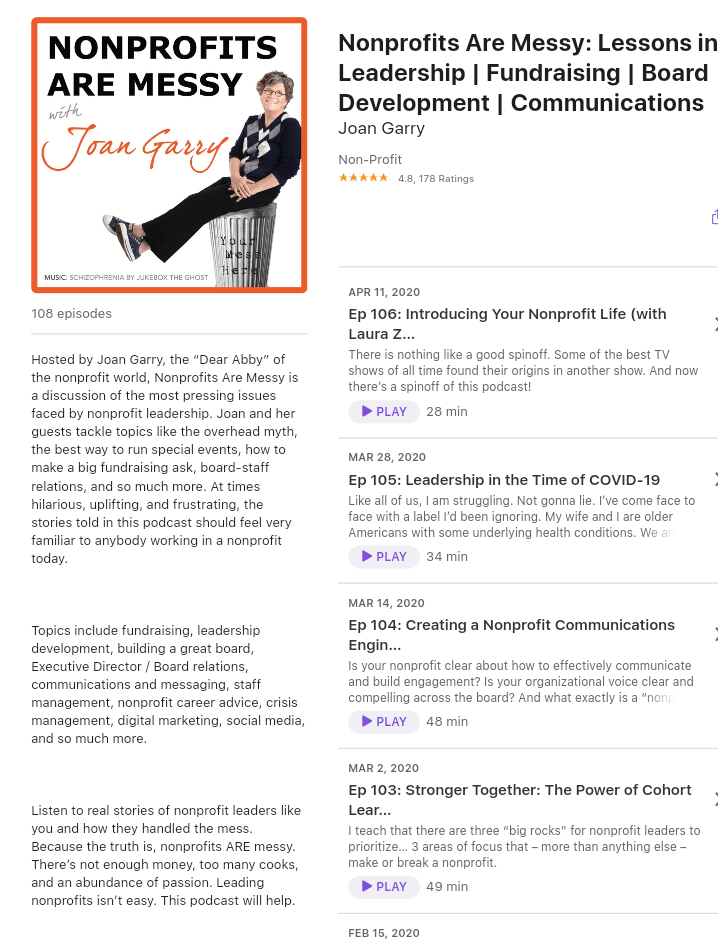How to Start a Nonprofit Podcast in 6 Steps

One increasingly effective way for organizations to grow their audience and generate awareness is to start a nonprofit podcast. The Breastcancer.org nonprofit podcast, for instance, offers unique insights into prevention, treatment, research, and other breast cancer topics from medical experts and invited guests. The podcast has grown in popularity and now has over 48,000 fans on Facebook and 19,000 followers on Twitter.
According to a 2017 study by Infinite Dials, 67 million Americans listen to at least one podcast per month. This listening rate has been growing by up to 10 to 20% per year. With the rise of smart home technologies like Google Home and Amazon Alexa, this trend will likely continue to gain traction.
Below we explore the benefits of podcasting for nonprofits and then we’ll walk through the six steps you can take to start one.
Benefits of Creating a Nonprofit Podcast
1. Connect With Your Audience Through Audio
Podcasts allow your organization to connect with supporters through a format other than videos, images, and blog posts. Because it’s audio, the listener can consume your content while on the move, such as while they’re exercising at the gym, cleaning around the house, or commuting to work. Audio is a portable and convenient format through which users can engage with your organization throughout their daily activities.
2. Grow Your Audience
Your organization can boost visibility by becoming searchable on different podcast platforms. If you host your nonprofit podcast on platforms like iTunes and Spotify, listeners can easily find you by searching specific topics or keywords. For example, if you host a nonprofit podcast for cancer survivors, whenever someone searches for a keyword related to cancer, your podcast would appear in the results.
3. Launch a Podcast for an Affordable Amount
You might be worried that starting a podcast for your nonprofit organization might eat into your already limited budget. However, you only need a few pieces of equipment to start your own podcast show.
Some of the essential items include a laptop, microphone, headset, pop filter, and an internet connection. If you already have a laptop, you can get the remaining items for less than $200.
4. Engage Niche Groups Within Your Cause
With podcasts, you can target a niche group with specific interests within your general audience. For instance, if you are a nonprofit that raises funds for breast cancer research and treatment, you can host podcast interviews specifically with breast cancer survivors. That’s what Susan G. Komen did with their nonprofit podcast, Real Pink, which highlights women who are currently battling breast cancer. Hearing an individual speak of their experience firsthand can create a strong emotional response from your audience.
Your nonprofit podcast can elevate and speak to different groups within your cause, thereby highlighting your impact from different angles and potentially reaching multiple cohorts impacted by your cause.
Now that we know the benefits of podcasts for nonprofits, let’s go over the steps for starting a podcast.
How to Start a Nonprofit Podcast in 6 Steps
1. Determine Your Topic and Target Audience
To run a successful podcast you need to create content for a specific niche. Just like blogging, you would only generate a significant return on investment and see more engagement when you create content for the right audience.
It’s also a good idea to conduct some upfront research to evaluate the demand for your desired topic.
You can easily research the topic or niche you have in mind by taking a look at Apple’s Podcast app or podcast directories like Stitcher.

The next step is to go to the categories and research the topic your podcast would touch on. For example, if you wanted to host a podcast for cancer awareness, you would check out the “science and medicine” category.
Check out the most popular podcast shows around your desired topic. These are some questions you should answer when analyzing a popular show:
- What kind of topics do they talk about?
- What content format do they use? Do they do more interviews or solo podcast shows?
- How long are their episodes?
- What do you like about their episodes as a listener?
Performing research on popular podcasts in your category can help you better understand your potential target audience and tailor your podcast show to appeal to their preferences.
2. Decide on Your Podcast Format
There are several popular podcast formats, and you can either decide to use one of the formats or experiment with a hybrid model that utilizes more than one format.
These are some of the most popular content formats:
- Hosted or co-hosted podcasts: In this type of podcast, you have the same host(s) who will discuss different topics in every episode.
- Interview podcasts: A regular host interviews a different guest or guests in each episode. This is one of the most popular types of podcasts. It can be easy to produce as what you mainly need is a list of questions and an expert guest.
- Narrative podcasts: This is the kind of podcast in which a narrator tells a story. This can be a very engaging format, though popular ones can often be more produced.
- Repurposed content podcasts: If you have a blog, you could repurpose your blog articles into an audio format, potentially exposing them to a new audience and offering a new medium to consume the content.
Use your first batch of episodes to determine which kind of format your audience loves best.
3. Create Your Brand
Defining the kind of content you want to put out is just one step in the creation process. Next, you need to choose a name, theme music, and design elements.
Choosing Your Podcast Name
When users are browsing through the podcast directory, they will see your podcast name and cover art first. Choose a name and cover art that grabs people’s attention and indicates what your podcast is about.
A good example is the “Nonprofits Are Messy” podcast run by Joan Garry. The show name is catchy and intriguing, and it appropriately hints that the podcast will uncover the real experiences of nonprofits. The podcast covers everything from nonprofit marketing, leadership, optimism, fundraising mistakes, and challenges that a nonprofit might face.
Creating Your Cover Art
Your cover art should be visually appealing and strategically branded. Consider using fonts and colors that are either part of, or reminiscent of, your brand, so listeners can connect the show to your organization. You may also want to use a colored background instead of a white or black background to stand out.
If you don’t have an in-house designer, you can use sites like Canva to create your cover art.

Write Your Podcast Description
Apart from your name and cover art, your podcast description is one of the biggest elements to prioritize, as it explains what your show is all about and why people should tune in.
Remember to optimize your podcast description for search engines. Include relevant keywords in your description so that people can easily find you online.

Choose Your Theme Music
Some of the most popular podcasts usually have catchy theme music. Listeners can recognize your podcast by your intro music, so remember to incorporate it into your intro and outro.
If you can’t employ someone to create a song for you because of budget, you can use a free directory like the Free Music Archive.
4. Choose Your Podcast-Hosting Provider
You need to choose a quality podcast hosting provider so that listeners won’t have any problems streaming or downloading your podcast episodes. These are media servers that store your episodes and large media files so that your listeners can easily stream or download them.
All podcast hosting providers have their advantages and disadvantages. These are some factors to consider when choosing your host:
- Price: The amount you would pay would determine the amount of space you need. When starting out, it’s best to choose smaller packages. As your audience grows, you can pay for upgrades.
- RSS support feed: Any host you choose should automatically create an RSS support feed for you.
- Embeddable player: Your hosting service should allow you to easily embed a player with episodes of your show on other platforms, such as your homepage, blog, or on social media.
- Site builder: Some podcast hosting services allow you to build a basic website where you can list all your podcast episodes. Some even allow you to create a more complete site where you can add other pages like an “about us” or contact page.
5. Record and Launch Your Podcast
After taking care of branding and selecting your hosting provider, the next step is to record and launch your podcast episodes.
While recording, make sure to use a quality microphone. You have to ensure that your audio is high-quality so that the listening experience is favorable and paints your organization in a professional light.
If you want to keep things simple, use a USB microphone. Just plug it into your computer and start recording. You won’t need any additional equipment or software. A USB mic is the best option if you are hosting a solo show.
If you will be recording with other people in-person, the best option would be a digital recorder. It would be difficult to record with multiple people using a USB mic on a single computer.
After recording and editing your episodes, you can then launch it on your podcast hosting provider of choice. Make sure to list them in top podcast directories like Apple’s Podcast app, Google Play Music, Stitcher, and Blubrry. You can also promote your podcast on your website or through email with show notes and a link.
The key to starting a nonprofit podcast is to take it one step at a time. Just remember that podcasting is a great way to attract donors while spreading your nonprofit’s mission to a much larger audience.
This is a guest post written by Marvellous Aham-adi. Marvellous is a freelance writer and content marketer. He teaches entrepreneurs and startups how to grow their brands using actionable marketing strategies at TheZeroed. He has been featured in top publications like Social Media Examiner, VWO, and OnCrawl.

The Nonprofit Digital Marketing Checklist



